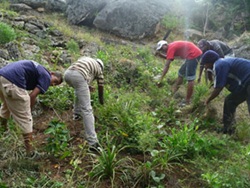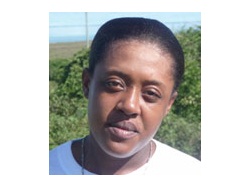 The original fauna and flora of Rodrigues is unique to the world; however, it has suffered from the onslaught of four centuries of degradationwhich has destroyed much of Rodrigues' rich biodiversity. Surviving plants are reduced to a single individual or a handful of individuals or small isolated populations. To address species decline and forest fragmentation, the Mauritian Wildlife Foundation has focused much of its expertise on habitat restoration. Anse Quitor is an interesting area with caves in which many bones of the extinct Solitaire and tortoise have been found, and plants grown in crater-like holes where little soil has gathered. Furthermore, Anse Quitor Nature Reserve holds the unique endemic tree of Zanthoxylum paniculatum and the rare Foetidia rodriguesiana, Terminalia benzoe, Antirhea bifurcata, and Gastonia rodriguesiana grow along the river banks in this nature reserve.
The original fauna and flora of Rodrigues is unique to the world; however, it has suffered from the onslaught of four centuries of degradationwhich has destroyed much of Rodrigues' rich biodiversity. Surviving plants are reduced to a single individual or a handful of individuals or small isolated populations. To address species decline and forest fragmentation, the Mauritian Wildlife Foundation has focused much of its expertise on habitat restoration. Anse Quitor is an interesting area with caves in which many bones of the extinct Solitaire and tortoise have been found, and plants grown in crater-like holes where little soil has gathered. Furthermore, Anse Quitor Nature Reserve holds the unique endemic tree of Zanthoxylum paniculatum and the rare Foetidia rodriguesiana, Terminalia benzoe, Antirhea bifurcata, and Gastonia rodriguesiana grow along the river banks in this nature reserve.
Restoration of Anse Quitor Nature Reserve (Rodrigues) project is about protecting the rare endemic plants of Rodrigues through the Restoration of Anse Quitor Nature Reserve (10.34 Ha, South West Rodrigues). Anse Quitor is one of the 4 nature reserves in Rodrigues and is a coastal dry ecosystem, with a limestone substrate.
The restoration of Anse Quitor Nature Reserve also contributes to increasing the area of restored forest thus, reducing global warming. Each seedling planted contributes to reduce the carbon dioxide in the atmosphere. Along with conserving Rodrigues endangered biodiversity, this project creates additional potential habitat for the only remaining endemic birds of Rodrigues (the Rodrigues Fody, Rodrigues Warbler) and supports the endangered Rodrigues Fruit Bat. Through recruiting a team of local villagers, this project shows that conservation can be a job provider. The region around Anse Quitor is one of the poorest areas of Rodrigues.
The employment of 6 restoration labourers allows each family to have more income in order to better their style of life, raise their children, and help their families financially. Educational talks and visits of the nature reserve are given in local schools, villages, and businesses and "Restoration Work Days" are organised to sensitise to the local villagers about the reserve, the endemic plants, and the importance of protecting them.
This project has been financed by the GEF Small Grants Programme in Mauritius with US$ 50,000 and other co funders include Conservation International, Taylor Smith Foundation, Air Mauritius, Philadelphia Zoo and Community Volunteers. The total cost of the project is estimated at US$ 172,000). The project funding by GEF SGP covers the period November 2009 to November 2011. However, this is a long-term restoration project that will continue, after 2011.
Some of the activities of the project include:
- Recruit & train 6 labourers from the local community
- Decrease the population of invasive alien species through their removal in 4 ha
- Propagate native & endemic species in the MWF Nursery at Solitude
- Restore 4ha in the Anse Quitor Nature Reserve including the planting of endemic seedlings
- Monitor the survival of the seedlings planted
- Organise educational visits to Anse Quitor Nature Reserve for the local community (schools, businesses, villages)
- Organise Restoration Work Days at Anse Quitor Nature Reserve or the MWF Nursery (Solitude) involving the local community
- Develop education and awareness material and information for the Anse Quitor Nature Reserve
This project is greatly contributing to the life of the community living around Anse Quitor region since six (6) labourers from villages surrounding Anse Quitor Nature Reserve have been employed for the period of the project. This has improved the style of life for each of these labourers by providing them with additional income. The 6 labourers recruited have been trained in plant identification, plant propagation, and restoration techniques. This training has made them more 'employable' as they already have knowledge and experience in propagation, habitat restoration, and other environmental issues.
 "Through the Anse Quitor Nature Reserve Project, I now have more knowledge of endemic plants and nature. I have discovered new places throughout the island while doing seed collection such as Cascade St Louis and many other places and have also learned a lot about the different types of plant propagation in the Nursery. Through my employment in this project, I have been able to raise the standard of living of my family as there is more income, and also provide a better education for my son", said Jenifa Jean, Restoration Labourer.
"Through the Anse Quitor Nature Reserve Project, I now have more knowledge of endemic plants and nature. I have discovered new places throughout the island while doing seed collection such as Cascade St Louis and many other places and have also learned a lot about the different types of plant propagation in the Nursery. Through my employment in this project, I have been able to raise the standard of living of my family as there is more income, and also provide a better education for my son", said Jenifa Jean, Restoration Labourer.
The Mauritian Wildlife Foundation has recently finished planting 40,000 native and endemic seedlings in the Anse Quitor Nature Reserve. This planting was done during the 'rainy season', which was mainly in February to May 2011, with the help of community volunteers during Restoration Work Days. Nearly every weekend and during the school holidays, the Mauritian Wildlife Foundation organised work days with various community groups such as Scouts, village groups, sports groups, and school groups.
Elie Farla, Restoration Labourer said: "This project has helped my family financially since I can now help my sister and brother with their schooling. I have also resumed my secondary school education, thanks to this job. This project has raised my standard of living and reinforced my general knowledge. I have learned about various methods of propagation and horticulture. It has also given me  information in other aspects of the environment".
information in other aspects of the environment".
During 2010, over 350 school students visited the project to learn about endemic plants, habitat restoration, and its importance and over 450 volunteers participated in Restoration Work Days in either Anse Quitor Nature Reserve or the MWF Nursery. The Restoration Work Days allows for the participants to 'learn by doing'. An educational folder, sticker, and poster have been created for the Anse Quitor Nature Reserve and are being distributed throughout the community. Weeding of Invasive Alien species have been and continue to be done in the 4ha restoration plot at Anse Quitor Nature Reserve. This restoration has allowed for the protection of 32 native and endemic Rodriguan plant species. Many of these plants are classified as threatened and have less than 5 individuals left in the wild. The Anse Quitor region hold the only remaining wild species of the Zanthoxylum paniculatum (critically endangered) and the last female Dombeya rodriguesiana is found in this area.
Media Contacts:
Ana Maria Currea, KM, GEF Small Grants PRogramme | This email address is being protected from spambots. You need JavaScript enabled to view it.
Mrs. Andrea Waterstone, Rodrigues Manager, Mauritian Wildlife Foundation | Phone number : +230 831 4558 | email address: This email address is being protected from spambots. You need JavaScript enabled to view it.




